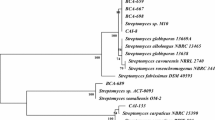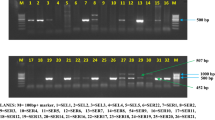Abstract
The antagonistic Trichoderma spp. isolates P1 and T3 differed in their ability to colonize and to compete in sphagnum peat moss and on wood chips. In peat supplemented with straw, isolate T3 produced twice as many colony forming units (cfu) as isolate P1. On wood chips, the two isolates formed a similar number of cfu. When the two Trichoderma isolates were cultivated together approximately 85–90% of the cfu were from T3 on both substrates. The presence of Pythium ultimum in peat amended with straw did not influence the number of Trichoderma cfu formed. The two Trichoderma isolates produced different amounts of hydrolytic enzymes both in liquid cultures and in peat. Seven different enzyme activities were tested. Enzyme production by T. harzianum isolate T3 was less influenced by the type of carbon source amendment than that of isolate T. atroviride P1. Culture filtrates of isolate P1 grown on complex carbon sources were high in endochitinase activity, whereas cellulase and endo-1,3-β-glucanase activities were more pronounced in filtrates of isolate T3. There was no significant difference between the two isolates in their ability to protect cucumber seedlings against P. ultimum while the combination of the two fungi resulted in significantly less biocontrol than each isolate alone.
Similar content being viewed by others
References
Chérif M and Benhamou N (1990) Cytochemical aspects of chitin break down during parasitic interaction of a Trichoderma spp. on Fusarium oxysporum f. sp. radicis-lycopersici. Phytopathology 80: 1406–1414
Deacon JW (1991) Significance of ecology in the development of biocontrol agents against soil-borne plant pathogens. Biocontr Sci Technol 1: 5–20
Deacon JW and Berry LA (1992) Modes of action of mycoparasites in relation to biocontrol of soilborne plant pathogens. In: Tjamos ES, Papavizas GC and Cook RJ (eds) Biological Control of Plant Diseases (pp 157–165) Plenum Press, New York
Duffy BK, Simon A and Weller DM (1996) Combination of Trichoderma koningii and fluorescent pseudomonads for control of take-all on wheat. Phytopathology 86: 188–194
Elad Y, Chet I and Henis Y (1981) A selective medium for improving quantitative isolation of Trichoderma spp. from soil. Phytoparasitica 9: 59–67
Gomez-Caballero I, Chet I and Herrera-Estrella A (1995) Genome organization and strain compatibility in Trichoderma harzianum. Abstract from the 18th Fungal Genetics Conference, March, 1995. Fung. Genet.Newsl. 42A-1995 supplement
Green H (1996) Ecology of Trichoderma spp. in relation to biocontrol of plant diseases caused by Pythium ultimum. Newtechnologies for autoecological investigations. Ph.D. thesis. Plant Pathology Section, Department of Plant Biology, The Royal Veterinary and Agricultural University, Denmark
Green H and Jensen DF (1995) A tool for monitoring Trichoderma harzianum: II. GUS transformants used for ecological studies in the rhizosphere. Phytopathology 85: 1436–1440
Harman GE, Taylor AG and Stasz TE (1989) Combining effective strains of Trichoderma harzianum and solid matrix priming to improve biological seed treatments. Plant Disease 73: 631–637
Harman GE, Hayes CK, Lorito M, Broadway RM, Di Pietro A and Tronsmo A (1993) Chitinolytic enzymes of Trichoderma harzianum: Purification of chitobiosidase and endochitinase. Phytopathology 83: 313–318
Hayes CK (1992) Improvement of Trichoderma and Gliocladium by genetic manipulation. In: Tjamos EC, Papavizas GC and Cook RJ (eds) Biological Control of Plant Diseases. Progress and Challenges for the Future (pp 277–286) Plenum Press, New York.
Ilmén M, Thrane C and Penttilä M (1996) The glucose repressor gene cre1 of Trichoderma: Isolation and expression of a full length and a truncated mutant form. Mol Gen Genet 251: 451–460
Jeffries P and Young TWK (1994) Interfungal Parasitic Relationships. CAB International, Wallingford, UK
Knudsen I, Hockenhull J and Jensen DF (1995) Biocontrol of seedling diseases of barley and wheat caused by Fusarium culmorum and Bipolaris sorokiniana: Effects of selected fungal antagonists on growth and yield components. Plant Pathology 44: 467–477
Lorito M, Harman GE, Hayes CK, Broadway RM, Tronsmo A, Woo SL and Di Pietro A (1993) Chitinolytic enzymes produced by Trichoderma harzianum: Antifungal activity of purified endochitinase and chitobiosidase. Phytopathology 83: 302–307
Lorito M, Hayes CK, Di Pietro A, Woo SL and Harman GE (1994) Purification, characterization, and synergistic activity of a glucan 1,3-?-glucosidase and an N-acetyl-?-glucosaminidase from Trichoderma harzianum. Phytopathology 84: 398–405
Lübeck M (1997) Marker genes and PCR based approaches as tools for monitoring fungi in soil: With emphasis on UP-PCR and fungi from the genera Trichoderma and Gliocladium. Ph.D. thesis. Plant Pathology Section, Department of Plant Biology, The Royal Veterinary and Agricultural University, Denmark
Lynch JM (1989) Environmental potential of the Trichoderma exocellular enzyme system. In: Lewis NG and Paice MG (eds) Plant cell wall polymers. Biogenesis and biodegradation. (pp 608–618) American Chemical Society. Washington DC
Migheli Q, Gonzáles-Candelas L, Dealessi L, Camponogara A and Ramón-Vidal D (1998) Transformants of Trichoderma longibrachiatum overexpressing the ?-1,4-endoglucanase gene egl1 show enhanced biocontrol effect on cucumber. Phytopathology 88: 673–677.
Paulitz T (1990) Biochemical and ecological aspects of competition in biological control. In: Baker RR and Dunn PE (eds) New Directions in Biological Control. Alternatives for Suppressing Agricultural Pests and Diseases (pp 713–724) Alan R. Liss, Inc., New York
Peberdy JF (1990) Fungal cell walls-A review. In: Kuhn PJ, Trinci APJ, Jung MJ, Goosey MW and Copping LG (eds) Biochemistry of Cell Walls and Membranes in Fungi (Chapter 2) Springer-Verlag, Brelin
Schickler H, Danin-Gelali BC, Haran S and Chet I (1998) Electrophoretic characterization of chitinases as a tool for the identification of Trichoderma harzianum strains. Mycol Res 102: 373–377
Sivan A and Chet I (1989a) Degradation of fungal cell walls by lytic enzymes of Trichoderma harzianum. J Gen Microbiol 135: 675–682
Sivan A and Chet I (1989b) The possible role of competition between Trichoderma harzianum and Fusarium oxysporum on rhizosphere colonization. Phytopathology 79: 198–203
Sivan A, Elad Y and Chet I (1984) Biological control effects of a new isolate of Trichoderma harzianum on Pythium aphanidermatum. Phytopathology 74: 498–501
Sivan A and Harman GE (1991) Improved rhizosphere competence in a protoplast fusion progeny of Trichoderma harzianum. J Gen Microbiol 137: 23–29
Thrane C, Lübeck M, Green H, Degefu Y, Thrane U, Allerup S and Jensen DF (1995) A tool for monitoring Trichoderma harzianum: I. Transformation with the GUS gene by protoplast technology. Phytopathology 85: 1428–1435
Thrane C, Tronsmo A and Jensen DF (1996) Monitoring the activity of different Trichoderma isolates by the isoelectric points (pI) of their extracellular enzymes. In: Jensen DF, Jansson H-B and Tronsmo A (eds) Monitoring Antagonistic Fungi Deliberately Released into the Environment (pp 105–111) Kluwer Academic Publishers, Netherlands
Thrane C, Tronsmo A and Jensen DF (1997) Endo-1,3-?-glucanase and cellulase from Trichoderma harzianum: Purification and partial characterization, induction by and biological activity against plant pathogenic Pythium spp. Eur J Plant Pathology 103: 331–344.
Tronsmo A (1989) Trichoderma harzianum used for biological control of storage rot on carrots. Nor J Agric Sci 3:157–161
Tronsmo A (1991) Biological and integrated controls of Botrytis cinerea on apple with Trichoderma harzianum. Biol Cont 1: 59–62
Tronsmo A and Dennis C (1978) Effect of temperature on antagonistic properties of Trichoderma species. Trans Br Myc Soc 71: 469–474
Tronsmo A and Harman GE (1993) Detection and quantification of N-acetyl-?-D-glucosaminidase, chitobiosidase, and endochitinase in solutions and on gels. Anal Biochem 208: 74–79
Webb EC (1992) Enzyme Nomenclature. International Union of Biochemistry and Molecular Biology. Academic Press, Inc., New York
Wolffhechel H (1989) Fungal antagonists of Pythium ultimum isolated from a disease suppressive sphagnum peat. Växtskyddsnotiser 53: 7–11
Wolffhechel H and Jensen DF (1992) Use of Trichoderma harzianum and Gliocladium virens for the biological control of post-emergence damping-off and the root rot of cucumbers caused by Pythium ultimum. J Phytopathol 136: 221–230
Woo SL, Donzelli B, Scala F, Mach R, Harman GE, Kubicek CP, Del Sorbo G and Lorito M. (1999) Disruption of the ech42 (endochitinase-encoding) gene affects biocontrol activity in Trichoderma harzianum P1. Mol Plant-Microbe Int 12: 419–429
Author information
Authors and Affiliations
Rights and permissions
About this article
Cite this article
Thrane, C., Jensen, D.F. & Tronsmo, A. Substrate Colonization, Strain Competition, Enzyme Production In Vitro, and Biocontrol of Pythium ultimum by Trichoderma spp. Isolates P1 and T3. European Journal of Plant Pathology 106, 215–225 (2000). https://doi.org/10.1023/A:1008798825014
Issue Date:
DOI: https://doi.org/10.1023/A:1008798825014




